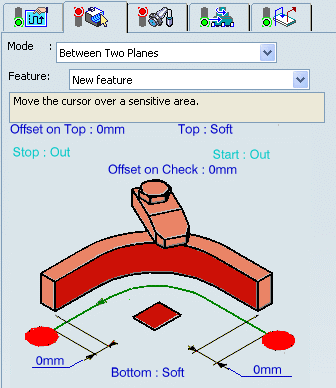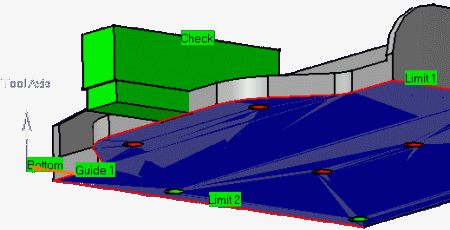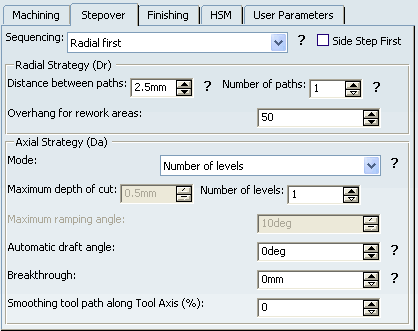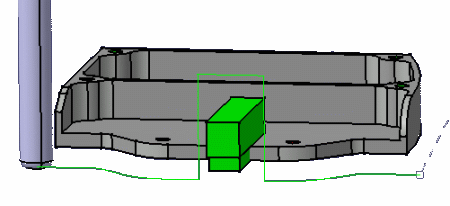Creating a Profile Contouring Operation: Between Two Planes | ||||||
|
| |||||
Activate the Manufacturing Program and click Profile Contouring
 in the Prismatic Machining Operations toolbar.
in the Prismatic Machining Operations toolbar.A Profile Contouring entity is added to the Manufacturing Program.
The Profile Contouring dialog box opens directly at the Geometry tab
 . This tab includes a sensitive icon to
help you specify the
geometry.
Areas of the icon are colored red indicating that this
geometry is required.
. This tab includes a sensitive icon to
help you specify the
geometry.
Areas of the icon are colored red indicating that this
geometry is required. 
Note: A Collision Checking capability is available in the Geometry tab, which allows collision checking between the tool and guide elements during macro motions.
Still in the Geometry tab.
- Set the Contouring mode to Between Two Planes.
- Set the Bottom type to Soft by
clicking the text, then set the Offset on Bottom to -5mm.
The part bottom and flanks are compulsory. All of the other parameters are optional.
- Click the red bottom in the icon, then select the underside of the part in the authoring window.
- Click the red flank in the icon, then select the profile along the front edge of the part in the authoring window.
- Right-click Start to set this condition to Out. Click the first relimiting element in the icon, then select the horizontal edge at one end of the contour profile in the authoring window.
- Right-click Stop to set this condition to Out. Click the second relimiting element in the icon, then select the horizontal edge at the other end of the contour profile in the authoring window.
- Click the check element in the icon, then select the top face of the green fixture in the authoring window.
The bottom, guide, limit, and check elements of the icon are now colored green indicating that this geometry is now defined. These are also indicated on the part.

- Choose the desired Tool path style.
- Set the machining criteria.
- Machining Parameters
such as machining tolerance
Note: Compensation output in the Machining tab allows you to manage the generation of Cutter compensation (CUTCOM) instructions in the NC data output.
- Stepover Parameters
- Finishing Parameters
- HSM Parameters
- User Parameters

Go to the Tool tab
 to select a tool.
to select a tool.Select the Feeds and Speeds tab
 to specify the feedrates and spindle speed parameters for the operation.
to specify the feedrates and spindle speed parameters for the operation.Select the Macros tab
 to specify transition paths.
to specify transition paths. See Defining Macros on Milling Operations
The specified operation uses a default linking macro to avoid collision with the selected fixture. You can optimize the linking macro and add approach and retract macros to the operation.
 By default,
a linking macro is applied, if a user-defined linking macro is not collision free.
By default,
a linking macro is applied, if a user-defined linking macro is not collision free.Click Tool Path Replay
 to check the validity of the operation.
to check the validity of the operation.- The tool path is computed.
- A progress indicator is displayed.
- You can cancel the tool path computation at any moment before 100% completion.

Click OK to create the operation.